Before I embark on the daunting process of reviewing an entire season of The Simpsons - or half a season, at least, as I’ll soon explain - I must make a confession. When the show hit the air early in 1990, I quickly developed a dislike for it. Yes, I acknowledge that I can display knee-jerk reactions against media fads, and since The Simpsons quickly became the hot show on my college campus and others, I went the other way, even though I’d barely examined the program in question.
Despite my negative mindset, I did eventually cultivate a positive passion for The Simpsons. Around Halloween of 1990, I caught a nasty case of the flu, and this kept me laid up for a while. With nothing better to do, I watched a lot of TV, and this included a Simpsons tape I borrowed from a friend. He’d tried to turn me on to their finer points, but it took my weakened state to finally get me to give it a whirl.
Much to my surprise, I really liked what I saw. From there I started to watch the show regularly, and here I sit, almost 11 years later, as a confirmed Simpsons geek. I have all the shows on videotape, and I plan to get every DVD release as they emerge. Heck, I even swallow up the action figures with a passion!
As such, it remains abundantly clear that I was wrong to judge The Simpsons without really giving them a chance. However, in my modest defense, one mitigating factor exists: those very first shows really weren’t that good. Granted, I’m sure they seemed terrific at the time, since a lot of this feeling may stem from hindsight; the later episodes really provided much more satisfying and entertaining experiences, and the earliest programs appear more crude and ill-developed by comparison. Nonetheless, I still really like those Season Two shows that made me a fan, so I can’t discount the notion that even with an open mind, I still might not have become a Simpsons fan based on the first season.
Season Two will receive a discussion some time in the future. Right now I need to expand upon my current feelings toward the first season, or half season, as it more accurately could be described. The characters first emerged via the Tracey Ullman Show. It ran from 1987 to 1989, and Matt Groening’s Simpsons shorts became one of its staples. The crew got their first full-length (half-hour) shot at the big time with a December 1989 Christmas program called “Simpsons Roasting On An Open Fire”. Soon after that, the regular series hit the air in January 1990, with “Bart the Genius” as the first episode.
Because the show didn’t start until halfway through the 1989-90 TV term, what we call the “first season” was really only half that length. As represented in this DVD packages, that meant we only got 13 episodes for Season One. In truth, this did form a little more than half a season; for example, Season Two included 22 shows, which makes Season One about 60 percent of a full term. It was still an abbreviated affair in any case.
Oddly, this fact may help The Simpsons: The Complete First Season sell better than it otherwise might. Granted, the pent-up demand for The Simpsons on DVD would ensure its success in any case, but the reduced number of episodes allowed Fox to offer the three-disc package for a very low list price of $39.98. Many fans recognize that the earlier episodes weren’t that good, but when we combine the novelty of having The Simpsons on DVD with the cheap cost, the end result becomes a big hit, no matter how people may feel about the programs.
And what about those episodes, anyway? Are they really as mediocre as I make them sound, or do they offer greater pleasures? In their original broadcast order, I’ll look at each show individually to document the lows, the highs, and the creamy middles. I’ll also mention each program’s production number; that information reveals that the shows weren’t always played in the order in which they were made.
DVD ONE:
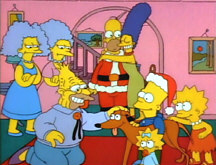 “Simpsons Roasting On An Open Fire” (aired December 17, 1989, #7G08): Though the eighth episode produced, this was the one that started it all for TV audiences. It made sense for its airdate to occur earliest, since “Roasting” was the only episode of the first 13 that had a seasonal theme.
“Simpsons Roasting On An Open Fire” (aired December 17, 1989, #7G08): Though the eighth episode produced, this was the one that started it all for TV audiences. It made sense for its airdate to occur earliest, since “Roasting” was the only episode of the first 13 that had a seasonal theme.
As implied by the title, “Roasting” takes place around Christmas. After Bart (voiced by Nancy Cartwright) gets a tattoo, mother Marge (Julie Kavner) must spend the family’s Christmas savings to get it removed. When father Homer (Dan Castellaneta) doesn’t get his expected Christmas bonus at work, he’s too meek to admit this to the family, so he takes on a second job as a department store Santa. This doesn’t pay as well as desired, so Homer bets it all - the whole $13 - at the dog track on a 99-to-1 shot named Santa’s Little Helper. The pooch comes in last and is abandoned by his owner, so he embraces another group of losers, the family Simpson.
For many years I thought of “Roasting” as a terrible episode, but it’s not. While I don’t feel it’s anything special, it remains a fairly entertaining show that has a few entertaining moments. I love the obnoxious refusal of Marge’s sister to speak to Homer on the phone, and it may be a cheap laugh, but Bart’s incomplete “mother” tattoo remains amusing. “Roasting” is good but not great early Simpsons.
Oddities: as we’ll see through other episodes, Barney (Castellaneta) had blond hair. He also seemed like more of a jerk, and neighbor Ned Flanders (Harry Shearer) appeared to be something of a yuppie, not the goody-goody Bible thumper we came to know.
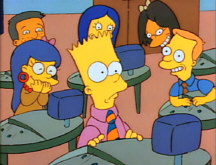 ”Bart the Genius” (aired January 14, 1990, episode 7G02): The second show produced, and the second broadcast - neat, huh? “Genius” stood as the first “real” program, in a way, since “Roasting” could be viewed as a holiday special; “Genius” started the show on its regular weekly run.
”Bart the Genius” (aired January 14, 1990, episode 7G02): The second show produced, and the second broadcast - neat, huh? “Genius” stood as the first “real” program, in a way, since “Roasting” could be viewed as a holiday special; “Genius” started the show on its regular weekly run.
Early in the show, brainy teacher’s pet Martin Prince (Russi Taylor) rats to Principal Skinner (Shearer) after Bart vandalizes the school’s outside wall. As revenge, Bart switches their IQ tests, and this results in the misbelief that Bart’s brilliant. He heads to a special school for gifted kids, where he runs into many frustrations. Ultimately, he admits his swindle.
As with “Roasting”, “Genius” offered another decent but unspectacular episode. Its early vintage seems clear both through the awkward animation and the lack of appropriate character development. Some elements feel out of place for Simpsons, such as Bart’s dream sequence when trying to complete a math problem. Still, it’s a watchable episode, with Homer’s reference to “opera dogs” being my favorite moment.
“Genius” marks the first official introduction of Bart’s peers like Martin and Milhouse (Pamela Hayden). We also see friends Lewis and Wendell (both performed by Taylor), but those kids would largely vanish in the long run, while Milhouse became Bart’s best friend. Martin also evolved into a friend as time progressed; the strong antagonism seen between the two in this show would definitely subside. Oddly, Milhouse sports black hair, not the blue tint he’d usually have.
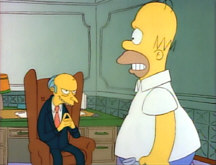 “Homer’s Odyssey” (aired January 21, 1990, episode 7G03): Possibly the best of the DVD One shows, “Odyssey” follows Homer after he loses his job. Despondent over his inability to find work, he goes to kill himself but gets interrupted by his family. A car nearly runs them over, and Homer discovers his new calling: as the town’s safety guy. When he challenges the dangerous aspects of the nuclear power plant - his old employer - boss Mr. Burns (Shearer) gives him a new job to keep him quiet.
“Homer’s Odyssey” (aired January 21, 1990, episode 7G03): Possibly the best of the DVD One shows, “Odyssey” follows Homer after he loses his job. Despondent over his inability to find work, he goes to kill himself but gets interrupted by his family. A car nearly runs them over, and Homer discovers his new calling: as the town’s safety guy. When he challenges the dangerous aspects of the nuclear power plant - his old employer - boss Mr. Burns (Shearer) gives him a new job to keep him quiet.
While I consider “Odyssey” to be the best of the DVD One bunch, that remains mild praise; I like most of these six shows to a degree, but they generally represent flat Simpsons. “Odyssey” suffers a little from an odd tone, as the characters hadn’t become settled. Still, it seems surprisingly clever and witty, especially given the downbeat nature of some events; how many shows threaten to kill their main character during their third broadcast?
Nonetheless, “Odyssey” established one Simpsons trademark: lots of fun little bits that added depth to the show. My favorite came when Homer arrived at his suicidal destination. He planned to jump off a bridge, and he brought a boulder to weigh him down after he leapt. When he arrived at the bridge, he finds a boulder already there. It’s small, but it’s funny. I also loved the semantic argument about Homer’s job as a technical supervisor.
Oddities, introductions: “Odyssey” marks the first onscreen appearances of Burns and his assistant Smithers (also voiced by Shearer); Burns was heard during “Roasting”, but not seen. The subject of much controversy and speculation, Smithers appears to be black in “Odyssey”. From what I understand, this was a mistake, not some failed form of social commentary. We also found the first appearance of Chief Wiggum (Hank Azaria). Barney’s still blond, and we see Bart’s first prank phone call to Moe’s.
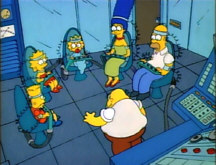 “There’s No Disgrace Like Home” (aired January 28, 1990, episode 7G04): My least favorite episode of Season One, though “Moaning Lisa” came a fairly close second. Still, “Disgrace” earned my disaffection because it showed the family with the least appropriate demeanors and interactions; it felt less like Simpsons than any of the other shows.
“There’s No Disgrace Like Home” (aired January 28, 1990, episode 7G04): My least favorite episode of Season One, though “Moaning Lisa” came a fairly close second. Still, “Disgrace” earned my disaffection because it showed the family with the least appropriate demeanors and interactions; it felt less like Simpsons than any of the other shows.
“Disgrace” follows the family as they go to the annual company picnic at Burns Manor. Despite Homer’s repeated requests to behave, the rest totally embarrass him, and he feels as though they’re the most dysfunctional family in Springfield. Eventually he lugs them to therapy with Dr. Marvin Monroe (Shearer), where they come together only after they nearly give the counselor a nervous breakdown.
Homer feels embarrassed by the others? Marge acts poorly in public and doesn’t care about the upkeep of the family? Lisa (Yeardley Smith) engages in pranks and silliness? This ain’t the family we’ve grown to know and love, and none of the episode’s gags are able to overcome the odd attitude. I won’t call “Disgrace” a terrible show, but it remains one of my all-time least favorites.
Oddities, introductions: Barney remains blond, but we get our very first look at Itchy and Scratchy.
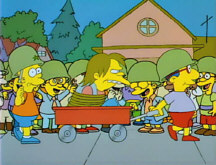 “Bart the General” (aired February 4, 1990, episode 7G05): DVD One’s only competition with “Odyssey” for the disc’s best show, “General” confronts the serious issue of school bullies through a series of touching, introspective vignettes. Yeah, right - this is The Simpsons, so don’t expect an insightful view of the subject. Instead, when class thug Nelson Muntz (Cartwright) picks on Bart, he goes to Homer for advice. His physical training does no good, so Lisa recommends that he consult Grampa Simpson (Castellaneta) since he’s the toughest of the clan. Grampa enlists the aid of war-obsessed wacko Herman (Shearer) and they train Bart’s downtrodden classmates; they form a legion that teaches Nelson a lesson.
“Bart the General” (aired February 4, 1990, episode 7G05): DVD One’s only competition with “Odyssey” for the disc’s best show, “General” confronts the serious issue of school bullies through a series of touching, introspective vignettes. Yeah, right - this is The Simpsons, so don’t expect an insightful view of the subject. Instead, when class thug Nelson Muntz (Cartwright) picks on Bart, he goes to Homer for advice. His physical training does no good, so Lisa recommends that he consult Grampa Simpson (Castellaneta) since he’s the toughest of the clan. Grampa enlists the aid of war-obsessed wacko Herman (Shearer) and they train Bart’s downtrodden classmates; they form a legion that teaches Nelson a lesson.
“General” lacks the subtlety and cleverness found on later episodes, but it was onto something, and it seems closer to top-notch Simpsons than many of this package’s other shows. “General” features a number of good lines and situations, but I most enjoy Grampa’s disgruntled letter to TV advertisers. By modern standards, “General” remains a primitive example of The Simpsons, but it’s a reasonably amusing and entertaining experience.
Introductions: in addition to Herman - who would remain little-seen in the future - “General” offered our first real look at Grampa. Marge referred to him during “Roasting”, but we never actually saw him in action until “General”. Of course, this was our first view of Nelson and his cronies as well, though the latter two wouldn’t reappear much, if at all. Lastly, bus driver Otto makes his first showing here.
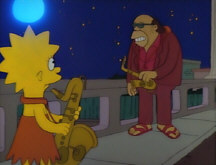 “Moaning Lisa” (aired February 11, 1990, episode 7G06): “Disgrace’s only competition as the worst of Season One, we learn a lesson that will serve us well over the years: episodes that focus on Lisa usually aren’t very good. Lisa feels sad, and no attempts to cheer her up succeed. Eventually, she hears the haunting sound of a sax as it wafts across town. Lisa heads out and meets Bleeding Gums Murphy (Ron Taylor), from whom she takes inspiration to do her own thing. However, Lisa remains glum until Marge recants her advice that her daughter should smile no matter what; once Marge permits her to be herself, Lisa brightens, and she gets to perform with Murphy at the Jazz Hole.
“Moaning Lisa” (aired February 11, 1990, episode 7G06): “Disgrace’s only competition as the worst of Season One, we learn a lesson that will serve us well over the years: episodes that focus on Lisa usually aren’t very good. Lisa feels sad, and no attempts to cheer her up succeed. Eventually, she hears the haunting sound of a sax as it wafts across town. Lisa heads out and meets Bleeding Gums Murphy (Ron Taylor), from whom she takes inspiration to do her own thing. However, Lisa remains glum until Marge recants her advice that her daughter should smile no matter what; once Marge permits her to be herself, Lisa brightens, and she gets to perform with Murphy at the Jazz Hole.
Overall, this was a pretty drab episode. It had some moments, such as the videogame boxing matches between Homer and Bart, but Lisa lacked the strength at this point to carry an entire show. Of all the main characters, the show’s producers seemed to have the most trouble getting a bead on Lisa; it took them quite some time to focus her personality, and though “Moaning” helped tighten her role, she still remained lackluster. “Moaning” is watchable but bland and unmemorable Simpsons.
Significant moments: only Murphy was introduced here, and he stayed very minor throughout the years. TV news anchorman Kent Brockman (Shearer) can be heard briefly, but we don’t actually meet him until later. And yes, Barney’s still light-haired.
DVD TWO:
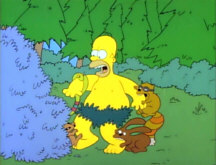 “Call of the Simpsons” (aired February 18, 1990, episode 7G09): The Simpsons started to become more special during the episodes seen on Disc Two, and “Call” begins that parade nicely. When Homer sees the fantastic new RV purchased by Flanders, he becomes envious and tries to top him. Unfortunately, Homer can’t afford much, so he buys a crappy little trailer instead. Despite their protests, he drags the family on a camping trip, where disaster ensues. The camper gets destroyed and the Simpsons are stranded. Homer and Bart head for help, but not successfully, while Maggie’s adopted by bears. Eventually, Homer’s mistaken for Bigfoot.
“Call of the Simpsons” (aired February 18, 1990, episode 7G09): The Simpsons started to become more special during the episodes seen on Disc Two, and “Call” begins that parade nicely. When Homer sees the fantastic new RV purchased by Flanders, he becomes envious and tries to top him. Unfortunately, Homer can’t afford much, so he buys a crappy little trailer instead. Despite their protests, he drags the family on a camping trip, where disaster ensues. The camper gets destroyed and the Simpsons are stranded. Homer and Bart head for help, but not successfully, while Maggie’s adopted by bears. Eventually, Homer’s mistaken for Bigfoot.
While “Call” doesn’t offer the continuous highs of the best Simpsons, it’s a generally solid show. The episode uses a wackier tone than usual for this era, but it works, and the program is consistently fun. Homer’s stint as Bigfoot remains fine, and I loved the bit when he tried to trap a rabbit. Guest-starring as RV salesman Bob, Albert Brooks provides a terrific cameo that garners some great laughs. Ultimately, “Call” is a lot of fun.
Oddities, introductions: Flanders remains a yuppie, but he seems more like the good-natured schlub we’d come to know. Otherwise, no new recurring characters appear, though we do hear our first mention of Bart’s lucky red hat.
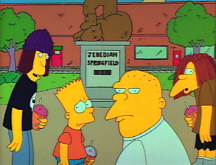 “The Telltale Head” (aired February 25, 1990, episode 7G07): Another good show, “Head” follows Bart as he succumbs to peer pressure. While on the way to a movie, he meets school bad boy Jimbo (Tress MacNeille) and his cronies Dolph (Hayden) and Kearney (Cartwright). They lead him to sneak into the theater with them, and Bart starts to learn some illegal activities. Eventually, they mention that they wish someone would lop off the head of the statue of town founder Jebediah Springfield. Due to his desire to fit in, Bart does so, but he finds that this is a mistake when everyone in Springfield - including Jimbo and the others - denounces the act. Bart has to redeem himself by the end.
“The Telltale Head” (aired February 25, 1990, episode 7G07): Another good show, “Head” follows Bart as he succumbs to peer pressure. While on the way to a movie, he meets school bad boy Jimbo (Tress MacNeille) and his cronies Dolph (Hayden) and Kearney (Cartwright). They lead him to sneak into the theater with them, and Bart starts to learn some illegal activities. Eventually, they mention that they wish someone would lop off the head of the statue of town founder Jebediah Springfield. Due to his desire to fit in, Bart does so, but he finds that this is a mistake when everyone in Springfield - including Jimbo and the others - denounces the act. Bart has to redeem himself by the end.
Good little moments abounded, and this was a generally solid episode. I liked the objects the boys saw in the clouds, and quite a few other funny bits appeared. “Telltale” wasn’t a great episode, but it was generally entertaining and clever.
Firsts also abounded in this program. In addition to Jimbo and his gang, “Head” brought us our first glimpses of Apu (Azaria), Krusty the Klown (Castellaneta), Reverend Lovejoy (Shearer), and Sideshow Bob (unvoiced here). And Barney’s hair color finally became brown!
 “Life on the Fast Lane” (aired March 18, 1990, episode 7G11): This one continued the positive tone seen in the prior couple of shows. After Homer forgets Marge’s birthday and then gives her a bowling ball really meant for himself, Marge tries to get back at him; though she’s never bowled in her life, she does so to spite Homer. At the Bowl-A-Rama, Marge meets Jacques (guest-star Albert Brooks), a local lothario who tries to seduce her via bowling lessons. As Homer seems unable to act, Marge clearly becomes enraptured by her potential affair, and she nearly cheats on her husband. However, she realizes that she really loves Homer in the end.
“Life on the Fast Lane” (aired March 18, 1990, episode 7G11): This one continued the positive tone seen in the prior couple of shows. After Homer forgets Marge’s birthday and then gives her a bowling ball really meant for himself, Marge tries to get back at him; though she’s never bowled in her life, she does so to spite Homer. At the Bowl-A-Rama, Marge meets Jacques (guest-star Albert Brooks), a local lothario who tries to seduce her via bowling lessons. As Homer seems unable to act, Marge clearly becomes enraptured by her potential affair, and she nearly cheats on her husband. However, she realizes that she really loves Homer in the end.
As was the case with “Call”, Albert Brooks seriously enlivened “Life”, as he would Season Five’s “Bart’s Inner Child”. Jacques becomes funny not so much due to the lines themselves; it’s Brooks’ readings that make them work. Marge suffered a little from lack of development; two additional Season One episodes featured plots that revolved around her disgust with Homer, and that seems a little heavy. Nonetheless, it was good to see her in the spotlight at this time, and the show helped her character grow. All in all, “Life” was another good but not great episode.
Introductions: “Life” gave us our first look at Helen Lovejoy (Maggie Roswell), the gossipy wife of the minister. I’m not sure, but I think this might be our first formal meeting of Homer’s coworker Lenny (Shearer).
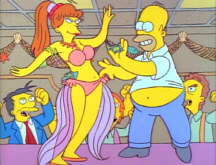 “Homer's Night Out” (aired March 25, 1990, episode 7G10): Yup, another fairly good episode, though probably not up to the level of the prior two. Here Homer goes to a bachelor party for a coworker. On their own, Marge and the kids visit the same restaurant unbeknownst to any of them, and when Bart heads to the can, he sees the shindig. While Homer boogies with exotic dancer Princess Kashmir (Roswell), Bart uses his new spy camera to take a snapshot. This image quickly makes the rounds through town, and eventually Marge gets a hold of it and boots Homer out of the house. To make up for her anger, Homer agrees to show Bart that it’s not right to treat women like objects.
“Homer's Night Out” (aired March 25, 1990, episode 7G10): Yup, another fairly good episode, though probably not up to the level of the prior two. Here Homer goes to a bachelor party for a coworker. On their own, Marge and the kids visit the same restaurant unbeknownst to any of them, and when Bart heads to the can, he sees the shindig. While Homer boogies with exotic dancer Princess Kashmir (Roswell), Bart uses his new spy camera to take a snapshot. This image quickly makes the rounds through town, and eventually Marge gets a hold of it and boots Homer out of the house. To make up for her anger, Homer agrees to show Bart that it’s not right to treat women like objects.
The concept of Marge’s anger at Homer got old, but this episode managed to offer a reasonably entertaining affair. It was fun to see Homer treated like a party god, and this offered a few nice moments. The overall level of quality remained good throughout the show, but it didn’t rise to any great heights.
Oddities and firsts: I think this was our first look at another coworker of Homer’s, Carl. Normally voiced by Azaria, I’m not sure who did the role here; Carl’s voice sounded very different. In addition, Lenny’s voice sounded like Moe’s. “Out” offered some of the program’s sloppiest moments. In addition, the animation looked more stiff and awkward than usual, and a mix of anomalies occurred, such as shots in which Princess Kashmir spoke but didn’t move her mouth.
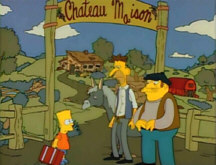 “The Crepes of Wrath” (aired April 15, 1990, episode 7G13): Still more good material from Season One. After Bart pulls one prank too many, Homer and Skinner conspire to send him to France as an exchange student. There he suffers at the hands of Ugolin and Cesar (Castellaneta and Shearer, respectively), two winemakers who force Bart to do all of their work. In the meantime, the Simpsons take in Adil (MacNeille), an Albanian boy who proves to be all the positive things Bart’s not. Marge and Lisa remain oddly suspicious of him, but Homer fully embraces the kid as the son he always wanted. Ultimately, Bart emerges heroic while Adil ends up something less than advertised.
“The Crepes of Wrath” (aired April 15, 1990, episode 7G13): Still more good material from Season One. After Bart pulls one prank too many, Homer and Skinner conspire to send him to France as an exchange student. There he suffers at the hands of Ugolin and Cesar (Castellaneta and Shearer, respectively), two winemakers who force Bart to do all of their work. In the meantime, the Simpsons take in Adil (MacNeille), an Albanian boy who proves to be all the positive things Bart’s not. Marge and Lisa remain oddly suspicious of him, but Homer fully embraces the kid as the son he always wanted. Ultimately, Bart emerges heroic while Adil ends up something less than advertised.
The last episode produced for Season One, it’s clear that they’d started to find their groove by this point. From start to finish, “Crepes” offered a solid experience, as the show began to feature more style and subtlety. Small bits like the talking Krusty doll at the beginning to Homer’s appearance in all of Adil’s pictures helped make the series great, and those elements accentuated some of the better parts of “Crepes”. Hey, it’s got a donkey wearing a baseball cap - what more could you want?
Introductions: only Skinner’s mother (MacNeille) joins our cast of recurring characters. Actually, I’m not 100 percent sure MacNeille did the voice here, as Agnes sounds different than she’d later appear. Many of the voices took time to solidify, so this one should seem like no exception.
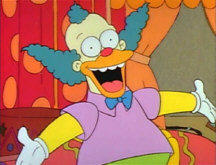 “Krusty Gets Busted” (aired April 29, 1990, episode 7G12): Almost undoubtedly the best of Season One, “Krusty” worked very well on many levels. At the start, Krusty appears to rob the Kwik-E-Mart, with Homer and Apu the only witnesses. The townsfolk quickly turn on the clown, as all except Bart convict him in their minds. Bart remains convinced of Krusty’s innocence, however, so he does what he can to find the real culprit.
“Krusty Gets Busted” (aired April 29, 1990, episode 7G12): Almost undoubtedly the best of Season One, “Krusty” worked very well on many levels. At the start, Krusty appears to rob the Kwik-E-Mart, with Homer and Apu the only witnesses. The townsfolk quickly turn on the clown, as all except Bart convict him in their minds. Bart remains convinced of Krusty’s innocence, however, so he does what he can to find the real culprit.
All throughout “Krusty”, we found great material; it really seemed clear that the show was starting to turn into the piece we now know and love. It’s hard for me to relate any deficiencies. We get our first real Itchy and Scratchy cartoon, plus the initial spoken material by Sideshow Bob (Kelsey Grammer). Almost every Bob episode offers a lot of fun, and “Krusty” started that trend in fine style. Grammer’s consistently excellent in the role, and everything about “Krusty”’s just great. Favorite line? When Patty and Selma narrate their vacation slides, they mention a “Mexican delicacy” called a “taco platter”. The Simpsons is an eminently quotable show, but most of Season One lacked fun lines like that; “Krusty” really began the program’s run of greatness.
In addition to the first speaking appearance of Sideshow Bob, “Krusty” provides our initial actual look at news anchor Kent Brockman. We heard from him earlier, but this was his true onscreen introduction. As for oddities, in a later show - Season Four’s “Homer’s Triple Bypass” - we learn that Krusty’s not wearing makeup, but he’s clearly without whiteface here. I believe this is the only time we see Krusty in this manner.
DVD THREE:
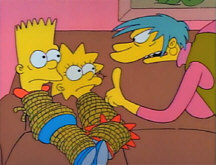 “Some Enchanted Evening” (aired May 13, 1990, episode 7G01): Though produced first, this was the last show broadcast in Season One. Apparently this occurred due to animation woes seen elsewhere on this disc, as the initial attempts looked terrible. Even with corrected work, the program’s roots as one of the earliest efforts seemed clear; all of the improvements seen during the last few disappeared quickly.
“Some Enchanted Evening” (aired May 13, 1990, episode 7G01): Though produced first, this was the last show broadcast in Season One. Apparently this occurred due to animation woes seen elsewhere on this disc, as the initial attempts looked terrible. Even with corrected work, the program’s roots as one of the earliest efforts seemed clear; all of the improvements seen during the last few disappeared quickly.
However, I thought “Evening” was a reasonably good episode. Once again, Homer upsets Marge; she calls radio therapist Marvin Monroe and vents all her concerns. Homer hears this, however, and preemptively gets back on her good side through plans for a big night out on the town. While they’re away, babysitter Ms. Botz (guest-star Penny Marshall) watches the kids, who discover she’s actually the notorious “Babysitter Bandit”. Bart and Lisa try to elude and capture her, but Homer inevitably botches the deal.
Since I watched the episodes in broadcast order, the appearance of “Evening” came as a stylistic shock. Most of the shows moved in production order as well, so I witnessed the gradual evolution of the animation and characters. “Evening” goes back to square one in many ways, though it wasn’t a total collapse. Actually, the characters seemed more “Simpsons-like” here than in some of the DVD One episodes; they didn’t display as many anachronistic tendencies as during a few other shows.
Still, it’s an awkward piece, and not one I enjoyed a great deal. To be sure, “Evening” was generally entertaining, but it’s nothing special. I liked Marshall’s turn as Botz, though she didn’t get much to do, and I was happy to see one of the few appearances of the Larry Davis Experience band, mainly because I work with a guy named Larry Davis. Otherwise, “Evening” was a watchable but unspectacular episode.
The DVD:
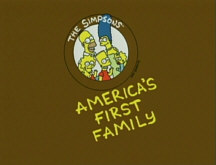 The Simpsons: The Complete First Season appears in an aspect ratio of 1.33:1 on these single-sided, double-layered DVDs; due to those dimensions, the image has not been enhanced for 16X9 televisions. Make no mistake: The Simpsons was created as a cheap TV animated series. As such, the programs generally looked somewhat weak, but my criticism was tempered by the fact that I thought virtually all of the problems were inevitable; they likely never looked any better than this.
The Simpsons: The Complete First Season appears in an aspect ratio of 1.33:1 on these single-sided, double-layered DVDs; due to those dimensions, the image has not been enhanced for 16X9 televisions. Make no mistake: The Simpsons was created as a cheap TV animated series. As such, the programs generally looked somewhat weak, but my criticism was tempered by the fact that I thought virtually all of the problems were inevitable; they likely never looked any better than this.
Sharpness seemed inconsistent. Most close-up shots came across as reasonably crisp and accurate, but wider images could be rather fuzzy and soft. Many edges looked blurry and rough, and what appeared to be edge enhancement showed up as well, though I’m not convinced that’s what it was; this animation process introduced its own haloes around characters, so it seemed very possible that these concerns resulted from the material’s inherent flaws.
These elements varied throughout the different episodes. As I watched them, it felt like “Bart the General” improved upon what I had seen prior, as it came across as moderately crisped and more vibrant, but these improvements were modest and temporary. Subsequent shows could regress to the less solid presentation of earlier work. Overall, the programs usually looked acceptably sharp, but they could be rather fuzzy at times.
Some source flaws came through in other ways. The images looked a bit unstable and wobbly at times, and a few speckles occurred as well. For the most part, the shows looked reasonably clean, however.
Colors tended to appear somewhat heavy and thick. The producers hadn’t gotten down the look of the program, and the use of colors followed this trend. As the DVDs progressed, the hues definitely started to look somewhat tighter, but not to a huge degree. As a whole, the tones seemed a little rough and noisy, and they never appeared very vivid or vibrant.
Black levels also had some woes. They seemed acceptably dark and solid, but they lacked much depth or force. Shadow detail was similarly erratic, and nighttime shots could be excessively opaque. “The Telltale Head” featured the most obvious moments of overly heavy shadows, but some other episodes betrayed the concerns as well.
Ultimately, it was very tough to pin a grade on these shows. Objectively, they looked fairly weak; anyone who expects pristine Simpsons will go away disappointed. Honestly, even though I knew the animation standards of Season One were below par, I was surprised at how ratty some of these shows seemed. Nonetheless, I felt that they generally adequately represented the original material, and though they could be pretty ugly at times, I still thought they merited a “C” for the whole package. Some shows nudged into “B” territory, while others fell to “D” range, but a “C” felt right for the overall set.
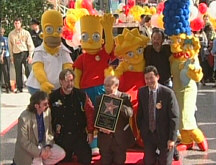 Much more satisfying was the Dolby Digital 5.1 audio heard in all these episodes of The Simpsons. Ironically, I expected less from the sound than I did from the visuals, but I found the audio to be much stronger. For the most part, the soundfield remained heavily anchored to the forward channels. At times I heard some general reinforcement from the surrounds, but there were very few instances in which they became an active part of the mix; they existed for ambience and little else.
Much more satisfying was the Dolby Digital 5.1 audio heard in all these episodes of The Simpsons. Ironically, I expected less from the sound than I did from the visuals, but I found the audio to be much stronger. For the most part, the soundfield remained heavily anchored to the forward channels. At times I heard some general reinforcement from the surrounds, but there were very few instances in which they became an active part of the mix; they existed for ambience and little else.
However, the forward spectrum came across as very involving and rich. Granted, much of the track remained essentially monaural. The music showed fine stereo presence, and a mix of atmospheric effects cropped up from the sides when appropriate; for example, the Bowl-A-Rama shots during “Fast Lane” provided a nice sense of placement. Still, these were dialogue-based shows for the most part, so don’t expect a tremendously active environment. Nonetheless, I was pleased with what I heard and thought the soundfield created a nice sense of environment.
That wasn’t enough to merit the “B” the audio received however. Simpsons earned that strong a grade due to the fine quality of the audio. I was very surprised at just how vibrant and full the shows sounded. A little edginess interfered with dialogue on a couple of occasions, but overall speech seemed to be warm and natural, and I detected no problems related to intelligibility. Effects were nicely accurate and distinct, and they showed solid dynamic range. For example, the dog race during “Roasting” demonstrated a nice rumble, and other elements of that sort came across with fine fidelity.
Where the audio really excelled, however, related to the music. At virtually all times, musical cues seemed to be bright and vibrant. From Danny Elfman’s opening theme to bits of score and music integrated into the various environments, these pieces showed fine clarity and depth. Take “Moaning Lisa”, for example; both the school band’s woeful rendition of “My Country Tis Of Thee” and Bleeding Gums’ version of Lisa's blues song demonstrated clean, vivid tones and offered surprisingly good delineation among the various instruments. A couple of source flaws appeared in a few episodes, like a minor hum heard occasionally during “Fast Lane”, but overall, the material seemed to be clear. Ultimately, the audio for The Simpsons came as a very pleasant experience.
While I and others would have been happy to get The Simpsons via “show-only” DVDs, Fox went above and beyond the call of duty and included a decent package of supplements. Easily the most intriguing are the audio commentaries that accompany all 13 episodes. The crew heard on these varies from show to show. Despite what the sticker on the back of the box told us, Groening didn’t appear on all 13 tracks; he was absent from three of them. Here’s a listing of the rosters for all 13 shows:
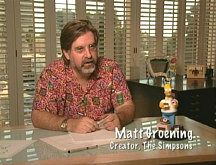 “Simpsons Roasting On an Open Fire”: Series creator Matt Groening, series developer James L. Brooks, and director David Silverman;
“Simpsons Roasting On an Open Fire”: Series creator Matt Groening, series developer James L. Brooks, and director David Silverman;
“Bart the Genius”: Groening, Brooks, Silverman and writer John Vitti;
“Homer’s Odyssey”: Groening, director Wes Archer, writers Jay Kogen and Wallace Wolodarsky;
“There’s No Disgrace Like Home”: Groening and writers Al Jean and Mike Reiss;
“Bart the General”: Groening, Brooks, Silverman;
“Moaning Lisa”: Groening, Archer, Jean and Reiss;
“Call of the Simpsons”: Archer, Jean and Reiss;
“The Telltale Head: director Rich Moore, Jean and Reiss;
“Life On the Fast Lane”: Groening, Brooks, Silverman, Jean;
“Homer’s Night Out”: Groening, Moore, Vitti;
“The Crepes of Wrath”: Archer, writer George Meyer;
“Krusty Gets Busted”: Groening, director Brad Bird, Kogen and Wolodarsky;
“Some Enchanted Evening”: Groening, Brooks, David Silverman.
As a Simpsons fanatic, I was eager to dig into these commentaries, and I generally found them to offer some good information and to provide an entertaining and enjoyable experience. However, some definite caveats applied. For one, the tracks started out strong, and the first few episodes gave us some good facts about the show. We learned about the growing pains they experienced and many other facets of the production.
However, a lot of these stories began to dry up as the season progressed. I don’t offer this as a complaint, really, for I can’t blame the participants. They made these shows many years ago, and considering that nearly 300 episodes have come since that time, it must be darned difficult to keep them straight. Nonetheless, be warned that toward the end of the season, the commentaries became less compelling and more empty spaces started to appear as well as additional remarks that did little more than relate the onscreen action. Actually, the last couple or three tracks were pretty good, especially when we got to “Evening”, an episode that was tough to complete. Nonetheless, as a whole the DVD Two commentaries were less compelling than those on DVD One.
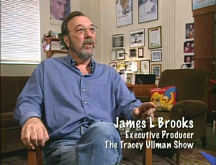 For die-hard Simpsons fans, these commentaries are a must-listen experience, even the ones that come across as less than informative. However, for those with a weaker commitment to the show, I don’t know if these tracks will be worth their while. The DVD One episodes should keep their attention, but some of the subsequent tracks seemed less compelling and might not merit the effort. In any case, I’m very pleased to have these commentaries, as they offered enough good material to allow me to enjoy them.
For die-hard Simpsons fans, these commentaries are a must-listen experience, even the ones that come across as less than informative. However, for those with a weaker commitment to the show, I don’t know if these tracks will be worth their while. The DVD One episodes should keep their attention, but some of the subsequent tracks seemed less compelling and might not merit the effort. In any case, I’m very pleased to have these commentaries, as they offered enough good material to allow me to enjoy them.
In addition to the six commentaries heard on DVD One, we also find scripts for a few episodes. The package includes text for “Bart the Genius”, “Bart the General” and “Moaning Lisa”. I’m not sure why we didn’t get scripts for all of the episodes, but I thought these were a fun addition nonetheless. They’re especially interesting because of a variety of handwritten notes and changes occasionally discovered on the paper.
DVD Two provided no extras other than the six commentaries, but DVD Three added a number of different features. In addition to the commentary for its sole episode and a script for that program as well, we get a mix of other pieces. During the aforementioned track for “Some Enchanted Evening”, we heard about some very poor animation created for it. “Evening” should have aired first, but its problems delayed it until last. In the “Never Before Seen Outtakes”, we find five minutes of material originally intended for the episode. Is it as bad as anticipated? I don’t think so - it’s a big step up above the nasty Tracey Ullman footage - but I agree it looks pretty weak.
For more about the material’s problems, we can listen to the Outtakes with commentary from Groening, Brooks, Silverman and Jean. Essentially the entire track consists of repeated cries of “oh my God!” The four consistently exhibit their disgust for the footage, and it’s very amusing to hear.
Next we find an Animatic From ‘Bart the General’. This piece shows one-minute and 48-seconds of a combination of rough pencil drawings and finished animation. Groening and Silverman narrate the program and offer a brief discussion of the process by which the drawings are made. It’s a minor extra but it’s reasonably interesting.
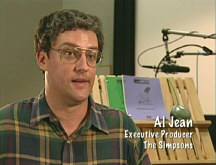 The Making of The Simpsons: America’s First Family offers another short video piece. Created in 2000 for the BBC, this clip runs for four minutes and 40 seconds and it provides a quick look at the show’s history and origins through clips and interview snippets with Groening, Brooks, Jean and animation critic Charles Solomon. Due to its brief running time, the show lacks depth, but it’s a fun look at the show’s early days.
The Making of The Simpsons: America’s First Family offers another short video piece. Created in 2000 for the BBC, this clip runs for four minutes and 40 seconds and it provides a quick look at the show’s history and origins through clips and interview snippets with Groening, Brooks, Jean and animation critic Charles Solomon. Due to its brief running time, the show lacks depth, but it’s a fun look at the show’s early days.
Foreign Language Clips provides one scene from “Life On the Fast Lane” that repeats in several different tongues. The same 63-second bit can be heard in French, Spanish, Italian, Japanese and Portuguese. They’re brief enough to remain interesting but not wear out their welcome. For the record, I thought the French Homer was the best of the bunch.
Up next is a Tracey Ullman Short called “Good Night Simpsons”. As I mentioned in the body of my main review, the Simpson family began their TV lives on The Tracey Ullman Show; they appeared in 48 shorts during the program’s run. Unfortunately, we only find one of these here. Actually, “unfortunately” may not be the right word. I’ve seen a few additional Ullman shorts and think they’re nearly unwatchable, so I can’t say I miss them, at least not for their entertainment value. However, they’d make a nice historical addition, so it’s too bad we only get this single clip. The first one ever aired, “Good Night Simpsons” runs for 115 unfunny seconds.
Much more compelling is the Albert Brooks Audio Outtakes From ‘Life On the Fast Lane’. Apparently Brooks improvised forever when he recorded his part as Jacques, and the DVD includes three minutes and 40 seconds of his material. It’s a lot of fun to hear, and I wish the disc had tossed in more, along with some evidence of his session as Bob from “Call of the Simpsons”.
Finally, the DVD ends with Art of The Simpsons. This provides two different sections. “Life In Hell” a single screen as it gives us a 1982 comic strip by Groening; apparently this was the one that caught producer James L. Brooks’ eye and helped lead the way to their collaboration. “Early Sketches and Drawings” includes a mix of art, highlighted by some character designs that didn’t make the cut; it was fun to see how participants like Mrs. Krabappel and Martin might have looked.
 In addition to these features, this package tosses in a couple of Easter eggs. From the “Art of The Simpsons” menu, click to the left and highlight Bart’s comic book. You’ll now find a nice little gallery of 12 different magazine covers on which the Simpsons have appeared.
In addition to these features, this package tosses in a couple of Easter eggs. From the “Art of The Simpsons” menu, click to the left and highlight Bart’s comic book. You’ll now find a nice little gallery of 12 different magazine covers on which the Simpsons have appeared.
Next, if you go to the second “Extra Features” screen and highlight the “Some Enchanted Evening” script, click to the left to light up Bart’s shirt. From there you can watch a 100-second news report that covers the 1990 controversy over some Simpsons T-shirts. Ah, those were the days!
Inside the DVD packaging we get a few other bits. A booklet provides brief comments about each of the 13 episodes as well as chapter listings. The case itself includes a funny note from Groening that welcomes us to “the first of many deluxe overpriced DVD sets of The Simpsons.”
Don’t you believe it: with a list price of only $39.98, The Simpsons: The Complete First Season is a steal. Almost none of the episodes can compete with the best that was yet to come in later seasons, but most of them remain entertaining and fun to see. The DVD provides appropriately rough visuals with surprisingly strong sound and a fairly nice mix of extras. Ultimately, all Simpsons fans will want to add this winner to their collections.